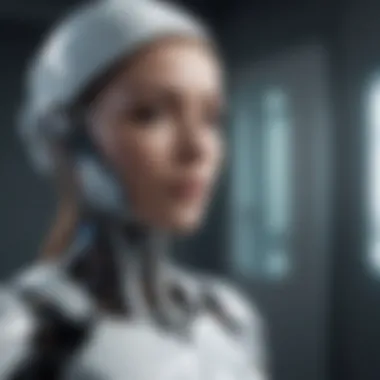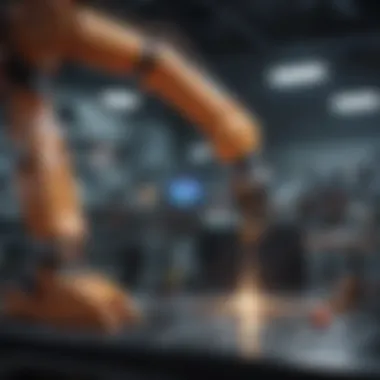Understanding Smart AI Robots: Innovations & Implications


Intro
The advent of smart AI robots signifies a profound shift in various sectors, including healthcare, manufacturing, and even domestic environments. As we navigate through this technological evolution, it is crucial to understand the fundamental aspects that define these innovations. Within the sphere of robotics, artificial intelligence plays a cardinal role, integrating complex algorithms with physical machinery. This convergence not only enhances operational efficiency but also raises vital ethical questions.
The importance of examining smart AI robots lies in their transformative potential. They are changing the way we approach tasks, solve problems, and interact with technology. By analyzing their implications and innovations, we can appreciate their impact on everyday life and anticipate future trends.
Understanding these systems is key for students, researchers, educators, and professionals alike. It enables a more informed discussion regarding the ethical considerations, potential applications, and the overarching influence of these intelligent machines in our society.
In this exploration, we will delve into the technological foundations, applications, ethical considerations, and future prospects of smart AI robots.
Prelims to Smart AI Robots
The emergence of smart AI robots marks a pivotal moment in technology, inceasingly influencing numerous sectors from healthcare to manufacturing. Understanding their capabilities and implications is essential for grasping the future landscape of various industries. Technology is evolving rapidly, and smart AI robots represent a fusion of artificial intelligence and robotics. This convergence offers an array of applications that are reshaping traditional practices, enhancing efficiency, and even building new models in businesses and healthcare.
Delving into the core of smart AI robots brings forth essential benefits. These robots not only increase productivity by automating tedious tasks, but also improve accuracy in complex operations -- a critical necessity in areas like surgery and manufacturing. Furthermore, their potential in data collection and analysis holds great promise for innovation. In an era where data drives decision-making, utilizing smart robots for data-gathering terrains can redefine organizational strategies. As we analyze the significance of smart AI robots, we must also address critical considerations regarding their development and deployment. Ethical concerns such as autonomy, privacy, and the future of employment must be acknowledged when engaging with this transformative technology.
A comprehensive understanding of smart AI robots requires us to define what constitutes their intelligence in the context of machines and explore their historical journey. This background provides valuable insight into the innovations that followed and the implications we continue to face today.
Technological Foundations
The technological foundations of smart AI robots encompass key elements that enable their functionality and advancement. Understanding these foundations is crucial as they not only illustrate how these robots work but also highlight their significance across various applications. This section will delve into the core components: artificial intelligence algorithms, and robotic systems. Each element is interlinked, creating a comprehensive framework that defines the capabilities and potential of smart AI robots.
Artificial Intelligence Algorithms
Artificial intelligence algorithms are the backbone of smart AI robots, driving their ability to learn and adapt to various environments. These algorithms provide the intelligence needed for decision-making processes. The capability to analyze large data sets and extract patterns is a defining characteristic of AI. This makes AI algorithms essential for enhancing robot performance.
Machine Learning
Machine learning is a specific form of AI that enables computers to learn and make decisions from data without explicit programming. This adaptability is what makes machine learning significant for smart robots. It allows robots to evolve their behavior over time, improving both efficiency and effectiveness in executing tasks.
The unique feature of machine learning is its ability to handle vast amounts of data. This characteristic gives it the edge in real-world applications where data is abundant. However, one challenge is that it requires significant computational resources to process this data effectively.
Deep Learning
Deep learning takes machine learning a step further by using neural networks that mimic human brain functioning. This contributes to the sophisticated processing of unstructured data like images and sounds. Deep learning is becoming a popular choice for systems that involve complex data inputs, increasing the usability of robots in tasks such as visual recognition and voice commands.
A notable advantage is its ability to improve performance as more data becomes available. However, it can lead to overfitting, where a model performs well on training data but poorly on new data, which is a crucial consideration.
Natural Language Processing
Natural language processing (NLP) allows robots to understand and interact with human language. This capability makes robots more autonomous in tasks that require communication, such as providing patient care or customer service. The ability to interpret nuanced language is a key characteristic of NLP, enhancing the interaction between robots and humans.
While NLP significantly boosts robot functionality, it does come with challenges such as understanding context and dealing with ambiguity in language. Despite these hurdles, its positive impact on the user experience remains critical.
Robotic Systems and Mechanics
The efficiency and functionality of smart AI robots also hinge on their mechanical systems. Robotic systems and mechanics involve various components that allow robots to move, sense, and interact with their environment. Understanding these aspects is fundamental to grasp their operational capacities.
Sensors and Actuators
Sensors and actuators are the devices that allow robots to perceive and react to their environment. Sensors gather data about external conditions, such as light, temperature, or obstacles. The actuators then use this information to perform actions like movement or manipulation. The integration of these two elements is vital for making robots responsive and effective.
A primary benefit is the robots’ ability to gather real-time data, making operations more efficient. Nonetheless, the challenge lies in ensuring the compatibility and reliability of various sensors and actuators used in robotic systems.
Control Systems


Control systems govern how robots respond to data received from sensors. They process input signals and dictate output actions, ensuring precision in operations. This system's importance in smart robots cannot be overstated, as it directly impacts performance consistency and reliability.
Control systems often employ feedback mechanisms to self-correct and adapt actions based on performance assessments. However, designing an effective control system can be complex, requiring careful consideration of various parameters such as latency and system stability.
Hardware Integration
Hardware integration involves combining different physical components within robots to work in unison. This integration is essential for creating a cohesive robotic system that can effectively carry out tasks. Successful hardware integration results in improved functionality, allowing robots to perform complex jobs.
One unique aspect is the ability to scale hardware components, which can enhance a robot’s capabilities or allow it to adapt for specific purposes. Yet, challenges may arise regarding physical space and energy consumption, which must be addressed during the design phase.
Applications of Smart AI Robots
In recent years, smart AI robots have found their way into various sectors, reshaping processes and enhancing efficiency. This section discusses the major applications of smart AI robots, focusing on their importance in healthcare, industry, and home environments. Each application not only showcases innovative technology but also opens discussions on ethical and practical considerations.
Healthcare Innovations
The healthcare sector has rapidly adopted smart AI robots. These innovations lead to improved patient outcomes and streamline various medical processes.
Surgical Robots
Surgical robots bring precision to operations that human hands may not achieve alone. These systems allow for minimally invasive surgery, reducing recovery times for patients. The key characteristic of surgical robots is their ability to perform complex procedures with heightened accuracy. This is beneficial because it results in less trauma for the patient and shorter hospital stays.
The unique feature of these robots is their use of advanced imaging technology, which assists surgeons in visualizing the procedure in real-time. This can significantly enhance surgical performance, though it also raises some concerns. For instance, the reliance on technology may lead to less hands-on experience for new surgeons.
Telemedicine
Telemedicine has gained importance, particularly during global health crises. This application allows doctors to consult patients remotely, increasing accessibility to healthcare. The key characteristic of telemedicine is its emphasis on convenience and efficiency. It can be particularly beneficial in rural areas where healthcare services are limited.
An unique aspect of telemedicine is that it can provide real-time monitoring of patients through wearable devices. However, there are concerns about data privacy and the quality of care provided. Misinterpretations can occur without physical examinations, so it’s crucial to weigh its pros and cons.
Patient Care Assistants
Patient care assistants enhance the overall patient experience by offering support in daily tasks and monitoring health status. The key characteristic of these robots is their ability to engage with patients on a personal level through conversation. This is beneficial for the elderly or those with chronic conditions who may need more regular assistance.
They often come with features such as medication reminders and emergency alerts, which can be lifesaving. However, there are challenges, too. Human interaction is crucial for emotional well-being, and relying on robots might lead to feelings of isolation in some patients.
Industrial Automation
Smart AI robots have revolutionized industrial processes. They improve efficiency, reduce costs, and enhance safety in workplaces.
Manufacturing Robots
Manufacturing robots focus on automating production lines. Their key characteristic is speed and precision in tasks that typically require human labor. This is beneficial as it can reduce production time and waste, leading to higher profitability.
An unique feature of these robots is often their adaptability. They can be programmed for various tasks, making them valuable for companies that need flexibility. Nevertheless, full automation can lead to job losses in certain sectors, raising ethical questions about workforce displacement.
Quality Control
Quality control maintains product standards, a critical aspect in manufacturing. Robotic systems assist in consistent and precise quality checks. The key characteristic of automated quality control is its efficiency in identifying defects that humans might miss. This is beneficial, ensuring higher overall product quality.
A unique feature is the integration of AI for predictive analytics, helping to anticipate issues before they arise. However, the reliance on robots raises concerns about accountability when defects are found after production.
Supply Chain Management
Supply chain management benefits from smart AI robots by optimizing logistics and reducing costs. Their key characteristic is the ability to analyze data in real-time, leading to faster decision-making. This is beneficial in a highly competitive market where time is critical.


An unique feature is the capacity for robots to track inventory levels automatically, ensuring that stocks are replenished efficiently. On the downside, disruptions in technology can halt operations, leading to losses.
Smart Home Integration
Smart AI robots are an integral part of the modern smart home, enhancing convenience and security.
Home Cleaning Robots
Home cleaning robots automate housekeeping tasks. Their key characteristic is their efficiency in keeping living spaces clean with little human intervention. This is beneficial as it frees up time for individuals.
An unique feature is their ability to navigate through homes using advanced sensors. Although they provide great convenience, there are limitations, such as their inability to clean all types of surfaces effectively.
Smart Security Systems
Smart security systems use AI to enhance home safety. Their key characteristic is the ability to monitor environments and send alerts. This system is beneficial as it allows homeowners to secure their properties remotely.
An unique feature is facial recognition technology, which can distinguish between family members and strangers. However, privacy issues arise when featuring constant surveillance.
Energy Management
Energy management systems optimize energy consumption in homes. Their key characteristic is the ability to analyze and adjust energy use based on household needs. This is beneficial for reducing utility bills.
An unique aspect includes automation features that adjust heating or cooling based on occupancy. This technology, however, may lead to over-dependence on automation, potentially causing issues if systems fail.
Ethical Considerations
The rise of smart AI robots brings forth critical ethical considerations that warrant thorough exploration. These considerations are integral to understanding the implications of these technologies. As we integrate AI and robotics into various aspects of our lives, it becomes essential to evaluate the responsibilities attached to their use. The development of autonomous systems raises questions about accountability. Who is responsible when an autonomous robot makes a mistake? The implications of attributing blame can lead to significant societal shifts. Thus, an in-depth examination of autonomy and responsibility is a crucial aspect of this conversation.
Autonomy and Responsibility
Autonomy in smart AI robots relates to their capability to operate independently, often performing tasks without human intervention. This independence creates a unique challenge regarding responsibility. If a robot malfunctions or acts in an unintended manner, determining accountability can be complicated. For instance, if a surgical robot makes an error, should the blame fall on the machine, the programmer, or the medical institution using it?
- Accountability Framework - Developing frameworks that clarify these responsibilities is vital. Nations may need new regulations or laws that address liability issues arising from autonomous robots' actions. This could include insurance models that account for robotic errors.
- Ethical Programming - Another consideration is the ethical programming of robots. The inclusion of ethical decision-making frameworks within their algorithms could provide guidance on how to act responsibly in situations where human safety or moral dilemmas arise.
Future discourse may focus on refining these principles of accountability while embracing technological growth.
Privacy and Security Issues
As smart AI robots become part of everyday life, they often collect, store, and analyze data. This activity raises significant privacy and security concerns. The way AI systems gather and use personal information must be transparent and secure.
- Data Collection Transparency - Users need clarity on what data is being collected. For example, a home assistant device, such as Amazon's Alexa, collects audio recordings. Understanding how this data is used and stored is essential for maintaining trust.
- Security Vulnerabilities - With increased connectivity comes potential vulnerabilities. For instance, hacking incidents involving smart home devices can expose personal data or compromise user safety. It is crucial that companies prioritize developing secure systems to protect user data from unauthorized access.
Addressing these privacy and security issues is necessary to foster trust in smart AI technologies, ensuring users feel safe in utilizing these innovations.
Job Displacement Concerns
One of the most discussed ethical implications of smart AI robots is the concern of job displacement. As automation increases, many occupations could see significant changes or even disappear. This trend can lead to various societal impacts.
- Workforce Disruption - Industries like manufacturing and logistics are already experiencing shifts. Robots are capable of performing tasks traditionally done by humans, leading to concerns about redundancy and unemployment in certain sectors.
- Reskilling and Workforce Adaptation - It is crucial to mitigate the impacts of displacement through education and reskilling programs aimed at preparing the workforce. Workers might need to evolve and learn new skills to remain competitive in a technology-driven job market.
- Economic Implications - The economic landscape may also shift. Fewer people employed in manual labor could lead to changes in spending patterns and economic power dynamics. Policymakers must consider how to address these shifts through legislation.
As we consider the implications of smart AI robots on employment, proactive strategies are essential to promote a balanced transition into an automated future.
"Understanding the ethical considerations of smart AI technology is pivotal for a healthy societal integration of these innovations."
Ultimately, grappling with the ethical implications surrounding smart AI robots is necessary. The responsibility for their actions, the protection of individual privacy, and the potential disruption to employment are interconnected challenges that must be thoughtfully navigated. Addressing these considerations will help shape a future where technology serves humanity positively.


Future Prospects
The exploration of future prospects for smart AI robots is crucial, as it paints a picture of the technological landscape evolving in the coming years. This section highlights various innovations that hold promise for enhancing the capabilities and functionalities of smart robots. Key elements such as enhanced learning capabilities, improved human-robot interactions, and integration with the Internet of Things (IoT) will be addressed in depth. Each of these factors not only contributes to the current narrative surrounding smart AI robots but also presents numerous benefits and considerations for various stakeholders. Understanding these future trends affords insights into both potential advancements and the challenges that may arise.
Technological Advancements on the Horizon
Enhanced Learning Capabilities
Enhanced learning capabilities present a significant aspect that can redefine how robots analyze and respond to their environment. This characteristic allows robots to adapt over time through incremental learning from interactions and experiences. A notable benefit of enhanced learning is its potential to optimize performance in complex situations where pre-programmed instructions may falter.
The unique feature of adaptive learning algorithms enables these systems to gain a deeper understanding of tasks and create more optimized outputs. However, the incorporation of such learning capabilities does come with some considerations, mainly regarding the data required for learning and the ethical ramifications of automated decision-making.
Improved Human-Robot Interaction
The improvement of human-robot interaction (HRI) is essential for integration of robots into daily life. This characteristic facilitates a more intuitive and seamless interface, whereby humans can communicate and collaborate with robots effortlessly. Enhanced HRI lays the groundwork for not only practical uses but also for social acceptance of these machines.
Moreover, the unique feature of using natural language processing and emotional recognition can lead to robots that understand both verbal and non-verbal cues. This capability can foster a more engaging collaboration but also raises questions about reliance on robots in sensitive interactions.
Integration with IoT
Integration with the Internet of Things is another promising aspect of smart AI robots. This integration enables smart robots to connect and communicate with other devices and systems, creating an interconnected ecosystem. A significant characteristic of this integration is the ability to gather and analyze data in real-time, which enhances overall functional efficiency.
A notable feature is the synergy achieved when robots operate in conjunction with home automation systems or industrial networks. This relationship can lead to improved decision-making capabilities based on data flow. However, challenges such as security vulnerabilities and the complexity of managing numerous connected devices remain considerations that need addressing.
Societal Impacts
Workforce Evolution
Workforce evolution is one aspect that highlights the transformative influence of smart AI robots. As various industries adopt robotic solutions, the nature of work is changing. This characteristic underscores the necessity for skills that complement automation rather than compete with it.
A unique feature in this evolution is the shift towards more strategic roles that require human oversight and creativity, rather than repetitive tasks. While this presents a chance for growth in professional development, it also raises concerns over job displacement and the need for retraining in the workforce.
Global Healthcare Enhancement
Global healthcare enhancement through smart AI robots reflects a substantial improvement in patient care and operational efficiency. This characteristic exemplifies how robots can assist in diagnostics, treatment plans, and managing routine tasks in healthcare frameworks.
The integration of robots in healthcare can streamline operations, allowing healthcare professionals to focus on critical aspects of patient care. However, reliance on technology also brings forth concerns about the variations in quality of care and ethical dilemmas surrounding automated intervention in health-related decisions.
Sustainable Development
Sustainable development is another area shaped by the integration of smart AI robots. The characteristic of energy efficiency in robotic processes can lead to a reduced ecological footprint while enhancing productivity. This makes robots an attractive option for sustainable initiatives across various sectors.
The unique feature of employing robots in renewable energy sectors or waste management processes presents opportunities for significant advancements. Meanwhile, potential disadvantages may arise from the energy consumption of a large swath of devices working simultaneously and the resources required to maintain such technology.
In summary, the future prospects of smart AI robots are vast and diverse. Each technological advancement and societal impact presents its opportunities and challenges, shaping the landscape for years to come.
End
The conclusions drawn in this article are pivotal for comprehending the multifaceted world of smart AI robots. They encapsulate not only the advancements in technology but also the shifts in societal norms and expectations. Understanding the implications and innovations introduced by these robots is crucial for various stakeholders, including educators, researchers, and industry professionals.
Summary of Key Insights
Smart AI robots represent a significant evolution in technological integration across multiple sectors. Key insights include:
- Technological Foundations: Advances in artificial intelligence algorithms, including machine learning and deep learning, provide the cognitive capabilities that power smart robots. Robotics systems have dramatically enhanced mechanical functions through improved sensors, actuators, and control systems.
- Diverse Applications: The impact of smart AI robots is profound in fields such as healthcare, where surgical robots and patient care assistants are transforming the delivery of medical services. In industrial settings, automation has led to enhanced manufacturing efficiencies and refined quality control processes.
- Ethical Considerations: The rise of autonomy in AI robots raises questions about responsibility and the implications for privacy and job displacement. Understanding these ethical ramifications is vital as society navigates the challenges posed by these technologies.
- Future Prospects: Innovations in human-robot interaction and integration with the Internet of Things suggest a promising future. Societal implications such as workforce evolution and sustainable development reveal the broad influence that smart AI robots may exert on everyday life.
Call for Further Research
The continuous evolution of smart AI robots warrants ongoing investigation and inquiry. Areas for further research include:
- Ethics and Policy: Exploring frameworks that govern the use of AI robots will be essential to address ethical dilemmas and ensure societal benefit.
- Human-Machine Interaction: Research on improving human-robot collaboration can lead to enhanced efficiencies in both professional and personal settings.
- Long-Term Societal Impacts: Understanding how these technologies will shape employment and the economy over time is imperative for preparing the workforce for changes that may arise.
Ultimately, the intersection of technology, ethics, and society in the context of smart AI robots highlights the need for a proactive approach to research and policy-making. As these robots become more embedded in our lives, the dialogues and studies surrounding their capabilities, limitations, and implications must advance.



